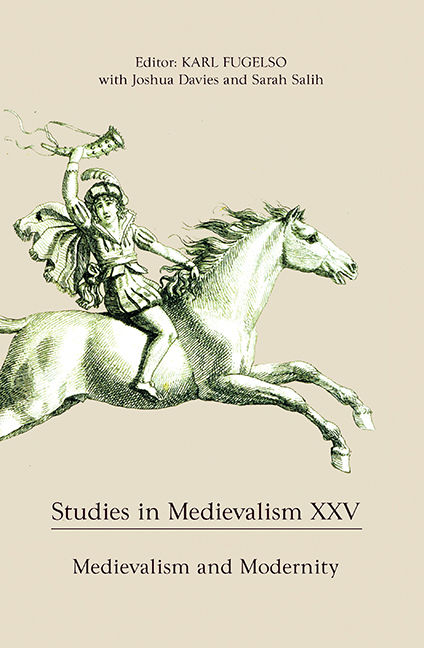Book contents
- Frontmatter
- Studies in Medievalism
- Acknowledgments
- Contents
- List of Illustrations
- Volume XXV 2016
- Editorial Note Karl Fugelso
- I Medievalism and Modernity: Some Perspective(s)
- II Medievalist Visions
- Introduction
- In/visible Medieval/isms
- Art, Heritage Industries, and the Legacy of William Morris in Michel Houellebecq's The Map and the Territory
- Travel in Space, Travel in Time: Michael Morrow's Approach to Performing Medieval Music in the 1960s
- Imagining Medieval Chester: Practice-based Medievalism, Scholarship, and Creativity
- The Anachronic Middle Ages: Public Art, Cultural Memory, and the Medievalist Imagination
- Medievalisms of Moral Panic: Borrowing the Past to Frame Fear in the Present
- Extra-Temporal Place Attachment and Adaptive Reuse: The Afterlives of Medieval English Anchorholds
- Here Be Dragons: Mapping Space and Time, Medieval and Modern
- Contributors
- Miscellaneous Endmatter
Extra-Temporal Place Attachment and Adaptive Reuse: The Afterlives of Medieval English Anchorholds
from II - Medievalist Visions
Published online by Cambridge University Press: 05 July 2016
- Frontmatter
- Studies in Medievalism
- Acknowledgments
- Contents
- List of Illustrations
- Volume XXV 2016
- Editorial Note Karl Fugelso
- I Medievalism and Modernity: Some Perspective(s)
- II Medievalist Visions
- Introduction
- In/visible Medieval/isms
- Art, Heritage Industries, and the Legacy of William Morris in Michel Houellebecq's The Map and the Territory
- Travel in Space, Travel in Time: Michael Morrow's Approach to Performing Medieval Music in the 1960s
- Imagining Medieval Chester: Practice-based Medievalism, Scholarship, and Creativity
- The Anachronic Middle Ages: Public Art, Cultural Memory, and the Medievalist Imagination
- Medievalisms of Moral Panic: Borrowing the Past to Frame Fear in the Present
- Extra-Temporal Place Attachment and Adaptive Reuse: The Afterlives of Medieval English Anchorholds
- Here Be Dragons: Mapping Space and Time, Medieval and Modern
- Contributors
- Miscellaneous Endmatter
Summary
Stephanie Trigg, in an essay on tourism and medieval cathedrals, suggests that the “institutions and practices of contemporary medieval tourism and heritage culture raise powerful questions for medievalists about the uses and significance of the medieval past.” In my quest to examine the modern remains of medieval spaces, I have been searching out extant anchorholds for the last fifteen years. Because these spaces are attached to working churches with a parish life, they have only rarely been preserved in their unadorned medieval state. Instead, the majority of anchorholds in Britain have been adaptively reused to fit the fabric of current parish life. Adaptive reuse allows culturally and historically important buildings to be redeveloped and repurposed instead of demolished. The practice considers and adapts the internal and external structure so that the character of the old influences the format of the new. In this way, both old and new become part of the fabric of cultural heritage. On a smaller scale, this is true of anchorholds as well. Over the course of my various journeys, I have come across several consistent reuses of medieval anchoritic spaces, all of which correspond to the main contributions of medieval anchorites to their parish communities: spiritual, social, and financial. In turn, each of these contributions can be connected with the manners in which churches – or in these cases anchorholds – are commonly adaptively reused: religious, community/multi-purpose/education, music/ theatre, exhibition, commercial, and residential. How these contributions are reflected in the various types of adaptations provides us with a unique perspective on the continuing importance of medieval heritage spaces.
Anchorholds were important spaces in medieval England, providing status for parish and community as well as housing for the religious practitioner inside. An anchorhold was often a small cell, sometimes attached to a church building, in which an anchoress or anchorite (an individual who lived a life of extreme vocational withdrawal) resided. Traditionally, they were assumed to have been built on the north side of the church, which was the coldest and most exposed to evil elements; however, my explorations of extant cells has indicated that was not always the case.
- Type
- Chapter
- Information
- Studies in Medievalism XXVMedievalism and Modernity, pp. 173 - 196Publisher: Boydell & BrewerPrint publication year: 2016



